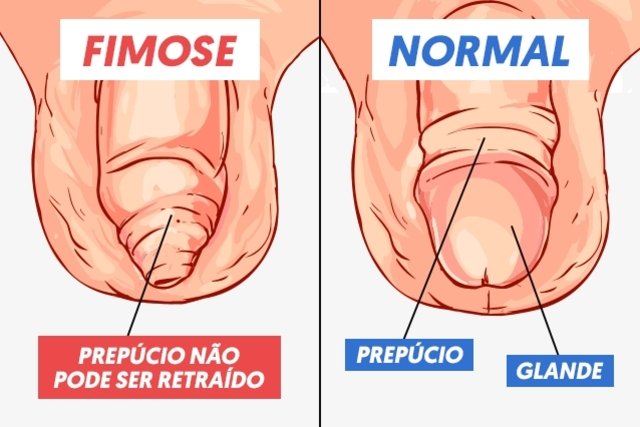Phimosis is an excess of skin, scientifically called foreskin, that covers the head of the penis, like a fibrous ring that causes difficulty or inability to expose the glans.
This condition is common in baby boys and tends to disappear in most cases by the age of 1, to a lesser extent by the age of 5 or only at puberty, without the need for specific treatment. However, when the skin does not yield enough over time, it may be necessary to use a specific ointment or undergo surgery.
Furthermore, other conditions can cause phimosis in adulthood, such as infections or skin problems, for example, which can cause pain, discomfort during sexual intercourse or urinary infections. In these cases, it is important to consult a urologist to begin the most appropriate treatment, which is normally done through surgery.

How to identify
The only way to identify and confirm the presence of phimosis is to try to manually retract the skin that covers the glans penis. When it is not possible to completely see the glans, this represents phimosis, which can be classified into 5 different degrees:
- Grau 1: the foreskin can be completely pulled back, but the base of the glans is still covered by skin and it may be more difficult to move the skin forward;
- Grau 2: it is possible to pull the foreskin, but the skin does not pass through the widest part of the glans;
- Grau 3: it is possible to pull the glans only up to the urinary orifice;
- Grau 4: the accumulation of skin is so great that the retraction of the foreskin is very reduced, making it impossible to expose the glans;
- Grau 5: more severe form of phimosis in which the skin of the foreskin cannot be pulled back, making it impossible to expose the glans.
Although the degree of phimosis is not very important in deciding the best treatment, which depends especially on the boy’s age, this classification can be useful for identifying phimosis and monitoring the progress of treatment. Generally, the first check for the presence of phimosis is made in the newborn baby, with the physical examination carried out by the pediatrician.
In the case of secondary phimosis, which can appear in adolescence or adulthood, the man himself can observe whether there is any difficulty in retracting the skin or symptoms such as redness, pain, swelling or bleeding in the head of the penis or in the foreskin, or symptoms of urinary infection such as pain or burning when urinating. In these cases, it is recommended to consult a urologist as soon as possible to carry out laboratory tests such as a blood count, urine test or bacterial culture test, for example.

Types of phimosis
Phimosis can be classified into some types according to its cause and characteristics, the main ones being:
1. Physiological or primary phimosis
Physiological or primary phimosis is the most common type of phimosis and can be present from birth in baby boys and occurs due to a normal adhesion between the inner layers of the foreskin and the glans, which is the head of the penis, causing complete retraction of the penis. harder foreskin.
2. Pathological or secondary phimosis
This type of phimosis can appear at any stage of life as a result of inflammation, repeated infection or local trauma, for example. One of the main causes of pathological phimosis is a lack of hygiene in the penis, which causes the accumulation of sweat, dirt, bacteria or other microorganisms, causing an infection that can lead to inflammation called balanitis or balanoposthitis.
Additionally, some skin diseases such as eczema, psoriasis or lichen planus, which leave the skin on the penis uneven, itchy and irritated, can cause secondary phimosis.
In some cases of phimosis, the skin is so tight that even urine can be trapped within the skin, increasing the risk of urinary infection. Phimosis can cause complications such as difficulty in cleaning the region, increased risk of urinary tract infection, pain during sexual intercourse, greater propensity to have a sexually transmitted infection, HPV or penile cancer, in addition to greatly increasing the risk of developing paraphimosis. which is when the foreskin becomes trapped and does not return to cover the glans.
How the treatment is carried out
The treatment of childhood phimosis should always be guided by a pediatrician and specific treatment is not always necessary, as phimosis can be naturally resolved up to 2 or 3 years of age. But if phimosis persists after this phase, treatment with ointments containing corticosteroids and exercises to retract the foreskin or surgery may be necessary after the age of 2.
The treatment of secondary phimosis must be carried out under the guidance of a urologist who may recommend surgery or prescribe antibacterial ointments with clindamycin or mupirocin or antifungals such as nystatin, clotrimazole or terbinafine, depending on the type of microorganism causing phimosis. Understand when phimosis surgery is indicated.
Furthermore, if secondary phimosis occurs due to sexually transmitted infections, the urologist must treat the infection with oral antibiotics or antivirals.
Find out more about treating phimosis.
Bibliography
- MINISTRY OF HEALTH. Phimosis: what it is, diagnosis, causes, symptoms and surgery. Available at: <http://www.saude.gov.br/saude-de-az/fimose>. Accessed on November 18, 2020
- STATPEARLS PUBLISHING. Phimosis. Available at: <https://www.ncbi.nlm.nih.gov/books/NBK525972/>. Accessed on November 18, 2020
- McGREGOR, Thomas B.; et al. Pathologic and physiologic phimosis. Can Fam Physician. 53. 3; 445–448, 2007
- HAYASHI, Yutaro Hayashi; et al. Prepuce: Phimosis, Paraphimosis, and Circumcision. The Scientific World Journal. 11. 289-301, 2011

Sign up for our newsletter and stay up to date with exclusive news
that can transform your routine!
Warning: Undefined array key "title" in /home/storelat/public_html/wp-content/plugins/link-whisper-premium/templates/frontend/related-posts.php on line 12
Warning: Undefined array key "title_tag" in /home/storelat/public_html/wp-content/plugins/link-whisper-premium/templates/frontend/related-posts.php on line 13



